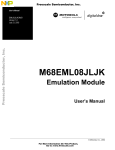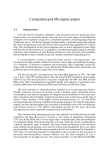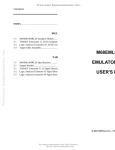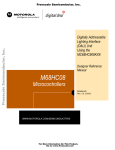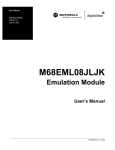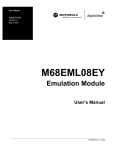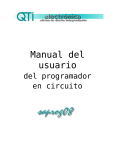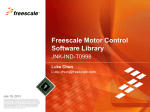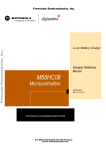Download M68EML08QBLTY
Transcript
Freescale Semiconductor User’s Manual M68EML08QBLTYUM Rev. 1.3, 08/2004 M68EML08QBLTY Emulation Module User’s Manual © Freescale Semiconductor, Inc., 2004. All rights reserved. Important Notice to Users While every effort has been made to ensure the accuracy of all information in this document, Motorola assumes no liability to any party for any loss or damage caused by errors or omissions or by statements of any kind in this document, its updates, supplements, or special editions, whether such errors are omissions or statements resulting from negligence, accident, or any other cause. Motorola further assumes no liability arising out of the application or use of any information, product, or system described herein: nor any liability for incidental or consequential damages arising from the use of this document. Motorola disclaims all warranties regarding the information contained herein, whether expressed, implied, or statutory, including implied warranties of merchantability or fitness for a particular purpose. Motorola makes no representation that the interconnection of products in the manner described herein will not infringe on existing or future patent rights, nor do the descriptions contained herein imply the granting or license to make, use or sell equipment constructed in accordance with this description. Trademarks This document includes these trademarks: Motorola and the Motorola logo are registered trademarks of Motorola, Inc. Windows is a registered trademark of Microsoft Corporation in the U.S. and other countries. Intel is a registered trademark of Intel Corporation. Motorola, Inc., is an Equal Opportunity / Affirmative Action Employer. For an electronic copy of this book, visit Motorola’s web site at http://e-www.motorola.com/ © Motorola, Inc., 2004; All Rights Reserved M68EML08QBLTY Emulation Module User’s Manual, Rev. 1.3 Freescale Semiconductor 2 User’s Manual — M68EML08QBLTY Emulation Module Table of Contents M68EML08QBLTY Quick Start Guide 1 - Set Jumpers W4 and W5 . . . . . . . . . . . . . . . . . . . . . . . . . . . . . . . . . 9 2 - Set Jumper W3 . . . . . . . . . . . . . . . . . . . . . . . . . . . . . . . . . . . . . . . . 9 3 - Install the emulation module into your development system . . . . . 9 4 - Connect the emulation module to your target system . . . . . . . . . . 10 5 - Install the development software. . . . . . . . . . . . . . . . . . . . . . . . . . 10 6 - Copy personality files to your computer . . . . . . . . . . . . . . . . . . . . 10 7 - Connect MMDS or MMEVS to your computer and apply power 11 Section 1. General Information 1.1 Introduction. . . . . . . . . . . . . . . . . . . . . . . . . . . . . . . . . . . . . . . . . . . . . 13 1.2 1.2.1 1.2.2 Development Systems. . . . . . . . . . . . . . . . . . . . . . . . . . . . . . . . . . . . . 13 Motorola Modular Development System (MMDS0508). . . . . . . . 13 Motorola Modular Evaluation System (MMEVS0508). . . . . . . . . 14 1.3 System Requirements . . . . . . . . . . . . . . . . . . . . . . . . . . . . . . . . . . . . . 15 1.4 EM Layout . . . . . . . . . . . . . . . . . . . . . . . . . . . . . . . . . . . . . . . . . . . . . 15 1.5 Specifications . . . . . . . . . . . . . . . . . . . . . . . . . . . . . . . . . . . . . . . . . . . 16 1.6 Target Cable Assemblies . . . . . . . . . . . . . . . . . . . . . . . . . . . . . . . . . . 17 Section 2. Preparation and Operation 2.1 Introduction. . . . . . . . . . . . . . . . . . . . . . . . . . . . . . . . . . . . . . . . . . . . . 19 2.2 Configuring Board Components . . . . . . . . . . . . . . . . . . . . . . . . . . . . . 20 2.3 Remaining System Installation . . . . . . . . . . . . . . . . . . . . . . . . . . . . . . 23 M68EML08QBLTY Emulation Module User’s Manual, Rev. 1.3 Freescale Semiconductor 3 2.4 Limitations . . . . . . . . . . . . . . . . . . . . . . . . . . . . . . . . . . . . . . . . . . . . . 24 2.5 Running the Automated Board Test . . . . . . . . . . . . . . . . . . . . . . . . . . 27 2.5.1 Set up the hardware . . . . . . . . . . . . . . . . . . . . . . . . . . . . . . . . . . . . 27 2.5.2 Install the test software . . . . . . . . . . . . . . . . . . . . . . . . . . . . . . . . . 28 2.5.3 Run the test. . . . . . . . . . . . . . . . . . . . . . . . . . . . . . . . . . . . . . . . . . . 28 Section 3. Support Information 3.1 Introduction. . . . . . . . . . . . . . . . . . . . . . . . . . . . . . . . . . . . . . . . . . . . . 29 3.2 Target Connector J1 . . . . . . . . . . . . . . . . . . . . . . . . . . . . . . . . . . . . . . 29 3.3 Logic Analyzer Connectors J2 and J13 . . . . . . . . . . . . . . . . . . . . . . . 30 3.4 Inverted Clock Connector J11 . . . . . . . . . . . . . . . . . . . . . . . . . . . . . . 32 3.5 Analog-to-Digital Converter Reference Voltage Connector E3. . . . . 32 3.6 Board Factory Test Connectors J12 and J14 . . . . . . . . . . . . . . . . . . . 33 3.7 Clock oscillator Y2 . . . . . . . . . . . . . . . . . . . . . . . . . . . . . . . . . . . . . . . 33 3.8 EM Board Socket Connectors P1 and P2 . . . . . . . . . . . . . . . . . . . . . . 33 M68EML08QBLTY Emulation Module User’s Manual, Rev. 1.3 4 Freescale Semiconductor User’s Manual — M68EML08QBLTY Emulation Module List of Figures 1-1 1-2 3-1 3-2 3-3 3-4 3-5 3-6 3-7 M68EML08QBLTY Emulator Module. . . . . . . . . . . . . . . . . . . . . . . 16 Target Cable Assembly . . . . . . . . . . . . . . . . . . . . . . . . . . . . . . . . . . . 18 Target Connector (J1) Pin Assignments . . . . . . . . . . . . . . . . . . . . . . 29 Logic Analyzer Connector J2 Pin Assignments . . . . . . . . . . . . . . . . 30 Logic Analyzer Connector J13 Pin Assignments . . . . . . . . . . . . . . . 31 Connector J11 Pin Assignments . . . . . . . . . . . . . . . . . . . . . . . . . . . . 32 Connector E3 Pin Assignments . . . . . . . . . . . . . . . . . . . . . . . . . . . . . 33 EM Connector P1 Pin Assignments. . . . . . . . . . . . . . . . . . . . . . . . . . 34 EM Connector P2 Pin Assignments. . . . . . . . . . . . . . . . . . . . . . . . . . 36 M68EML08QBLTY Emulation Module User’s Manual, Rev. 1.3 Freescale Semiconductor 5 M68EML08QBLTY Emulation Module User’s Manual, Rev. 1.3 6 Freescale Semiconductor User’s Manual — M68EML08QBLTY Emulation Module List of Tables 1-1 1-2 2-1 3-1 3-2 3-3 3-4 3-5 3-6 3-7 Specifications. . . . . . . . . . . . . . . . . . . . . . . . . . . . . . . . . . . . . . . . . . . 16 M68EML08QBLTY Target Cable and Head Assemblies. . . . . . . . . 17 Configuration Components . . . . . . . . . . . . . . . . . . . . . . . . . . . . . . . . 20 Target Connector (J1) Signal Descriptions . . . . . . . . . . . . . . . . . . . . 30 Logic Analyzer Connector J2 Signal Descriptions . . . . . . . . . . . . . . 31 Logic Analyzer Connector J13 Signal Descriptions . . . . . . . . . . . . . 32 Connector J11 Signal Descriptions . . . . . . . . . . . . . . . . . . . . . . . . . . 32 Connector E3 Signal Descriptions . . . . . . . . . . . . . . . . . . . . . . . . . . . 33 EM Connector P1 Signal Descriptions . . . . . . . . . . . . . . . . . . . . . . . 35 EM Connector P2 Signal Descriptions . . . . . . . . . . . . . . . . . . . . . . . 37 M68EML08QBLTY Emulation Module User’s Manual, Rev. 1.3 Freescale Semiconductor 7 M68EML08QBLTY Emulation Module User’s Manual, Rev. 1.3 8 Freescale Semiconductor 1 - Set Jumpers W4 and W5 User’s Manual — M68EML08QBLTY Emulation Module M68EML08QBLTY Quick Start Guide Make sure that power is disconnected from your M68EML08QBLTY Emulator Module and from your target system. Then follow these quick-start steps to make your M68EML08QBLTY ready for use as quickly as possible. 1 - Set Jumpers W4 and W5 Set jumper headers W4 and W5 to specify the MCU you wish to emulate: • Jumper W4 specifies the MCU suffix (ex. 1, 2, 3, 4, 5 or 8) • Jumper W5 specifies the MCU family (QT/QY, QL or QB) 2 - Set Jumper W3 Set 6-pin header W3 to specify the clock source for the EM MCU when external clock is enabled (you must switch from internal clock to external clock in your software): • Jumper between pins 1 and 2 = Replaceable EM 32.768 kHz oscillator Y1 • Jumper between pins 3 and 4 = Debugger-controlled PFB oscillator (factory default) • Jumper between pins 5 and 6 = XTAL, 4.9152 MHz crystal at Y2 3 - Install the emulation module into your development system To use the M68EML08QBLTY in an MMDS0508 Motorola Modular Development System (MMDS) or MMEVS0508 Motorola Modular Evaluation System (MMEVS): M68EML08QBLTY Emulation Module User’s Manual, Rev. 1.3 Freescale Semiconductor 9 4 - Connect the emulation module to your target system • Remove the access panel of the station-module enclosure if using an MMDS • Insert the M68EML08QBLTY through the access-panel opening • Fit together M68EML08QBLTY connectors P1 and P2 (on the bottom of the board) to connectors P11 and P12, respectively, of the MMDS or MMEVS control board • Snap the corners of the M68EML08QBLTY onto the plastic standoffs 4 - Connect the emulation module to your target system Use a target flex A cable, appropriate target head adapter, and surface mount adapter. Plug the appropriate end of the flex cable into M68EML08QBLTY connector J1. • If the M68EML08QBLTY is in an MMDS station module, run the flex cable through the slit in the station-module enclosure, then replace the access panel. • Plug the other end of the flex cable into the target head. Solder the appropriate surface mount adapter to your target if necessary. Then plug the target head into the surface mount adapter on your target system. 5 - Install the development software Refer to your development software installation or user guide. 6 - Copy personality files to your computer The factory ships M68EML08QBLTY MCU personality files on the documentation CD-ROM. • If you’re using the CodeWarrior IDE, find the installation directory and copy the personality files named 00C75Vxx.mem, 00C76Vxx.mem, and 00C7EVxx.mem from the documentation CD-ROM to the ...\prog\reg subdirectory of the CodeWarrior IDE main directory. M68EML08QBLTY Emulation Module User’s Manual, Rev. 1.3 10 Freescale Semiconductor 7 - Connect MMDS or MMEVS to your computer and apply power • If you’re using the P&E debugger, copy these files to the installation directory that contains MMDS08.EXE or MMEVS08.EXE and rename them from 00C75Vxx.mem, 00C76Vxx.mem, and 00C7EVxx.mem to 00475Vxx.mem, 00476Vxx.mem, and 0047EVxx.mem respectively. 7 - Connect MMDS or MMEVS to your computer and apply power When you make sure that the serial cable connections between your development system and your computer are sound, you are ready to apply power and use your M68EML08QBLTY. This completes the quick start for your M68EML08QBLTY. M68EML08QBLTY Emulation Module User’s Manual, Rev. 1.3 Freescale Semiconductor 11 7 - Connect MMDS or MMEVS to your computer and apply power M68EML08QBLTY Emulation Module User’s Manual, Rev. 1.3 12 Freescale Semiconductor Introduction User’s Manual — M68EML08QBLTY Emulation Module Section 1. General Information 1.1 Introduction This user’s manual explains connection and configuration of the Motorola M68EML08QBLTY Emulator Module. The M68EML08QBLTY makes possible emulation and debugging of target systems based on MC68HC908QL2 (alpha version only), MC68HC908QL3 (alpha version only), MC68HC908QL4 (alpha version only), MC68HC908QT1/QY1, MC68HC908QT2/QY2, MC68HC908QT4/QY4, MC68HC908QT8/QY8, MC68HC908QB4, or MC68HC908QB8 microcontroller units (MCU). The M68EML08QBLTY can be part of two development systems. This section describes those systems and explains the layout of the M68EML08QBLTY. 1.2 Development Systems Your M68EML08QBLTY can be part of two Motorola HC08 processor family development systems: the MMDS0508 Motorola Modular Development System (MMDS) or the MMEVS0508 Evaluation System (MMEVS). Refer to the specific development system user’s manual for more information. 1.2.1 Motorola Modular Development System (MMDS0508) The MMDS is an emulator system that provides a bus state analyzer and real-time memory windows for designing and debugging a target system. A complete MMDS consists of: • a Station Module — the metal MMDS enclosure, containing the platform board and the internal power supply. Most system cables connect to the MMDS station module. • an Emulator Module (EM) — such as the M68EML08QBLTY, a separately- purchased printed circuit board that enables system functionality for a specific set of MCUs. The EM fits into the station module through a removable panel in the enclosure top. The EM has M68EML08QBLTY Emulation Module User’s Manual, Rev. 1.3 Freescale Semiconductor 13 Development Systems connectors for a target cable and for cables to a logic analyzer. The cable runs to an optional target system through an aperture in the station-module enclosure, to connect directly to the emulator module. • Two logic clip cable assemblies — twisted-pair cables that connect the station module to your target system, a test fixture, an oscillator, or any other circuitry useful for evaluation or analysis. One end of each cable assembly has a molded connector, which fits into station-module pod A or pod B. Leads at the other end of each cable terminate in female probe tips. Ball clips come with the cable assemblies and may be attached to the female probe tips. • a 9-lead RS-232 Serial Cable — the cable that connects the MMDS to the host computer RS-232 port. • System Software — development software, on CD-ROM. • MMDS0508 Documentation — an MMDS operations manual (MMDS0508OM/D) and the appropriate EM user’s manual. You select the MMDS baud rate: 1200, 2400, 4800, 9600, 19200, 38400, 57600, or 115200. Substituting a different EM enables your MMDS to emulate target systems based on different MCUs or MCU families. (Your Motorola representative can explain all the EMs available.) 1.2.2 Motorola Modular Evaluation System (MMEVS0508) An MMEVS is an economical tool for designing, debugging, and evaluating target systems. A complete MMEVS consists of: • a Platform Board (PFB) — the bottom board, which supports the emulator module. The platform board has connectors for power and the the terminal or host computer. • an Emulator Module (EM) — such as the M68EML08QBLTY, a separately purchased printed circuit board that enables system functionality for a specific set of MCUs. The EM fits onto the PFB. The EM has connectors for the target cable and for cables to a logic analyzer. • a 9-to-25-pin Adapter — a molded assembly that lets you connect the 9-pin cable to a 25-pin serial port. M68EML08QBLTY Emulation Module User’s Manual, Rev. 1.3 14 Freescale Semiconductor System Requirements • a 9-lead RS-232 Serial Cable — the cable that connects the station module to the host computer RS-232 port. • System Software — development software, supplied on CD-ROM. • MMEVS0508 Documentation — an MMEVS operations manual (MMEVSOM/D) and the appropriate EM user’s manual. An MMEVS features automatic baud rate selection: 2400, 4800, 9600, 19200, 38400, or 57600. Substituting a different EM enables your MMEVS to emulate target systems based on different MCUs or MCU families. (Your Motorola representative can explain all the EMs available.). 1.3 System Requirements An IBM PC or compatible running Windows 98, Windows 2000, Windows NT (version 4.0), or Windows XP with at least 32MB of RAM and an RS-232 serial port. 1.4 EM Layout Figure 1-1 shows the layout of the M68EML08QBLTY. Jumper header W1 specifies the operating voltage. Jumper header W2 is a programming header that selects between the QB8 and the QL4. Jumper header W3 specifies the clock signal source. Jumper headers W4 and W5 specify the MCU to be emulated. Target interface connector J1 connects the M68EML08QBLTY to a target system, via the included target cable assembly. If you use your M68EML08QBLTY as part of an MMDS, run the target cable assembly through the slit in the station module enclosure. Connectors J2 and J13 connect to an external logic analyzer. Connector J11 is the source for an inverted clock signal. DIN connectors P1 and P2, on the bottom of the board connect the M68EML08QBLTY to the platform board. The emulation MCU (MC68HC908GZ60) is at location U4. An MC68HC908QB8 is located at U19 and an MC68HC908QL4 is at location U25. These two processors are used only to generate the emulation clock. The Connector E3 provides the A/D reference voltages. Connectors J12 and J14 are for EM board design and factory use only. M68EML08QBLTY Emulation Module User’s Manual, Rev. 1.3 Freescale Semiconductor 15 Specifications W1 VMCUSel E2 VMCU E1 GND U4 J2 W2 E3 A/D REF U19 P1 P2 J11 OSC2 U25 J1 U27 J12 E5 GND U31 W3 OSC Sel W4 E8 GND MCU Sel J13 Y1 E9 GND J14 W5 Figure 1-1 M68EML08QBLTY Emulator Module 1.5 Specifications Table 1-1 lists M68EML08QBLTY specifications Table 1-1 Specifications Characteristic Specifications Maximum Clock speed 32-MHz at 5V (8-MHz bus), 16-MHz at 3V (4-MHz bus) Temperature operating storage -10° to +50° C -40° to +85° C MCU Extension I/O HCMOS Compatible at Vmcu (5V or 3V) Relative humidity 0 to 90% (noncondensing) Power requirements 5VDC supplied from the MMDS or MMEVS Dimensions 5.5 X 8.0 X 0.75 inches (139.7 x 203.2 x 19.1 mm) M68EML08QBLTY Emulation Module User’s Manual, Rev. 1.3 16 Freescale Semiconductor Target Cable Assemblies 1.6 Target Cable Assemblies To connect your M68EML08QBLTY to a target system, you need a target cable and a target head adapter and footprint for the package you are using. See Figure 1-2. The cable assembly consists of: a flex cable, a target head adapter, a male-to-male socket-saver and depending on your package, a surface mount adapter. One end of the target cable plugs onto M68EML08QBLTY connector J1. The other end of the flex cable plugs onto the target head adapter, which plugs onto a DIP MCU socket or a surface mount adapter. You should solder the surface mount adapter directly onto the target-system board in place of the MCU. The socket-saver goes between the target head adapter and MCU socket or surface mount adapter. If you use it, it will reduce wear on the target head adapter. After many insertions, you can replace the socket-saver without replacing the entire target head adapter. Table 1-2 lists target cable and head part numbers appropriate for the M68EML08QBLTY. Table 1-2 M68EML08QBLTY Target Cable and Head Assemblies Flex Cable Part Number Target Head Adapter Part Number Surface Mount Adapter Part Number Socket-Saver Part Number 8-pin PDIP (QT) M68CBL05A M68TA08QTP8 User-Supplied Thru-Hole DIP Socket Samtec APA-308-G-A1 8-pin SOIC (QT) M68CBL05A M68TA08QTP8 M68DIP8SOIC Samtec APA-308-G-A1 8-pin DFN (QT) M68CBL05A M68TA08QTDFN8 M68DIP8DFN Samtec APA-308-G-A1 16-pin PDIP (QY, QB) M68CBL05A M68TA08QYP16 User-Supplied Thru-Hole DIP Socket Samtec APA-316-G-A1 16-pin SOIC (QY, QB) M68CBL05A M68TA08QYP16 M68DIP16SOIC Samtec APA-316-G-A1 16-pin TSSOP (QY, QB) M68CBL05A M68TA08QYT16 M68DIP16TSSOP Samtec APA-316-G-A1 16-pin PDIP (QL) M68CBL05A M68TA08QLP16 User-Supplied Thru-Hole DIP Socket Samtec APA-316-G-A1 16-pin SOIC (QL) M68CBL05A M68TA08QLP16 M68DIP16SOIC Samtec APA-316-G-A1 16-pin TSSOP (QL) M68CBL05A M68TA08QLDT16 M68DIP16TSSOP Samtec APA-316-G-A1 MCU Package M68EML08QBLTY Emulation Module User’s Manual, Rev. 1.3 Freescale Semiconductor 17 Target Cable Assemblies Figure 1-2 Target Cable Assembly M68EML08QBLTY Emulation Module User’s Manual, Rev. 1.3 18 Freescale Semiconductor Introduction User’s Manual — M68EML08QBLTY Emulation Module Section 2. Preparation and Operation 2.1 Introduction This section explains M68EML08QBLTY preparation: how to set board jumpers and how to make system connections. Note that you can reconfigure an M68EML08QBLTY already installed in an MMDS0508 station module enclosure. To do so, switch off station-module power and target power, remove the panel, then follow the guidance of this section. Similarly, you can reconfigure an M68EML08QBLTY already installed on the MMEVS platform board, provided that you disconnect platform-board power and target power. CAUTION: ESD Protection Motorola development systems include open-construction printed circuit boards that contain static-sensitive components. These boards are subject to damage from electrostatic discharge (ESD). To prevent such damage, you must use static-safe work surfaces and grounding straps, as defined in ANSI/EOS/ESD S6.1 and ANSI/EOS/ESD S4.1. All handling of these boards must be in accordance with ANSI/EAI 625. M68EML08QBLTY Emulation Module User’s Manual, Rev. 1.3 Freescale Semiconductor 19 Configuring Board Components 2.2 Configuring Board Components Table 2-1 is a summary of configuration settings. Table 2-1 Configuration Components Component Position Voltage Select Header, W1 Note: The tracking function is enabled out of the factory. This header is not populated on factory boards. You must remove resistor R2 and solder a 2x3 header onto the board if you wish to use forced 3V or 5V operation. Effect TRCK: Specifies that the voltage tracks the target voltage (2.7V to 5.5V). W1 1 2 5 6 Note: This is the factory setting. You must remove resistor R2 to turn off this setting. (Use only one jumper in this header.) 5V: Specifies 5.0-volt operating power. W1 1 2 5 6 3V: Specifies 3.0-volt operating power. W1 MON08 MCU Header, W2 1 2 5 6 QB: Sets the board up for programming the QB part W2 3 (Use only one jumper in this header.) 1 NOTE: This header is only used in the factory. Customers should not use this header or attempt to reprogram the MCUs QL: Sets the board up for programming the QL part W2 3 1 NOTE: This header is only used in the factory. Customers should not use this header or attempt to reprogram the MCUs M68EML08QBLTY Emulation Module User’s Manual, Rev. 1.3 20 Freescale Semiconductor Configuring Board Components Table 2-1 Configuration Components (Continued) Component Position Oscillator Select Header, W3 (Use only one jumper in this header.) PFB: Specifies the oscillator clock signal from the platform board (PFB). W3 1 2 5 6 1 2 5 6 XTAL: Specifies the clock signal from a 4.9152-megahertz crystal on the EM board installed at Y2 (XTAL). W3 Settings other than those described here are not currently supported. (Use only one jumper in this header.) Factory setting EM: Specifies the clock signal from the removable 32.768-kilohertz oscillator on the EM board installed at Y1 (EM). W3 1 2 5 6 MCU Suffix Select Header, W4 Effect 8: Specifies an MCU suffix of 8 (ex., QT8, QY8 or QB8). W4 1 2 9 10 15 16 Factory setting 1: Specifies an MCU suffix of 1 (ex., QT1 or QY1). W4 1 2 9 10 15 16 2: Specifies an MCU suffix of 2 (ex., QL2, QT2 or QY2). W4 1 2 9 10 15 16 M68EML08QBLTY Emulation Module User’s Manual, Rev. 1.3 Freescale Semiconductor 21 Configuring Board Components Table 2-1 Configuration Components (Continued) Component Position Effect 3: Specifies an MCU suffix of 3 (ex., QL3). W4 1 2 9 10 15 16 4: Specifies an MCU suffix of 4 (ex., QL4, QT4, QY4 or QB4). W4 1 2 9 10 15 16 5: Specifies an MCU suffix of 5 (Not Supported). W4 1 2 9 10 15 16 MCU Family Select Header, W5 QB: Specifies emulation of a QB family MCU W5 1 2 5 6 Factory setting QTQY: Specifies emulation of a QT or QY family MCU. W5 1 2 5 6 QL: Specifies emulation of a QL family MCU. W5 1 2 5 6 Note: Eemulation is only valid for the alpha version of the QL family MCUs. M68EML08QBLTY Emulation Module User’s Manual, Rev. 1.3 22 Freescale Semiconductor Remaining System Installation 2.3 Remaining System Installation When you have configured jumper headers, you are ready to complete M68EML08QBLTY installation: • To install the M68EML08QBLTY in an MMDS0508 station module, remove the panel from the station module top. Fit together EM connectors P1 and P2 (on the bottom of the board) and platform-board connectors P11 and P12, respectively. Snap the corners of the EM onto the plastic standoffs. Connect the target cable, if appropriate, then replace the panel. • If your M68EML08QBLTY already is installed in the station module, reconnect the target cable (if necessary). Replace the panel. • To install the M68EML08QBLTY on an MMEVS platform board, fit together EM connectors P1 and P2 (on the bottom of the board) and platform-board connectors P11 and P12, respectively. Snap the corners of the EM onto the plastic standoffs. • If you will use the P&E development software, copy personality files 00C75Vxx.mem, 00C76Vxx.mem, and 00C7EVxx.mem from the documentation CD-ROM to the installation directory that contains file MMDS08.EXE or MMEVS08.EXE. Then rename these files to 00475Vxx.mem, 00476Vxx.mem, and 0047EVxx.mem respectively. • If you will use the CodeWarrior IDE development software, copy personality files 00C75Vxx.mem, 00C76Vxx.mem, and 00C7EVxx.mem from the documentation CD-ROM to the ...\prog\mem subdirectory of the CodeWarrior IDE installation directory. Additionally, if you will use CodeWarrior IDE development software, you will need to copy the M68EML08QBLTY register files MCU0C75.reg, MCU0C76.reg, and MCU0C7E.reg from the documentation CD-ROM to the ...\prog\reg subdirectory of the CodeWarrior IDE installation directory. The CodeWarrior IDE uses these files to implement optional functionality such as letting you view or modify register contents by name rather than by address. A register file is an ASCII text file, which you may customize. (The CodeWarrior IDE user’s manual explains how to create and use such files.) M68EML08QBLTY Emulation Module User’s Manual, Rev. 1.3 Freescale Semiconductor 23 Limitations At this point, you are ready to make any remaining cable connections and apply power. For instructions, consult the MMDS or MMEVS operations manual. 2.4 Limitations Limitations listed here apply to using your M68EML08QBLTY versus using the actual MCU in your target system: Limitation 1 - Port A Data Register (PORTA): If you set PORT A Data Direction register bit 6, then PORT A Data register (DDRA) bit 6, indicating and auto-wakeup interrupt, will not read correctly. You should always clear DDRA bit 6.. Limitation 2 - Data Direction Register A (DDRA): It is possible to set bit 2 of DDRA as an output. This will cause PORT A bit 2 not to read as an input, but as what you set in the data register. You should always clear DDRA bit 2. Limitation 3 - Port A and B Input Pullup Enable Register (PTAPUE and PTBPUE): All bits of PTAPUE are write-only and their values will not be displayed correctly when read. Bits 6 and 7 of PTBPUE are write only and their values are 0 when read. You should not use read-modify-write operations on these registers (such as BCLR or BSET instructions). When emulating QB4, QB8, or QT/QY8 the Port A Pullup register (PTAPUE) is located at $0D instead of $0B. Limitation 4 - Configuration Register 2 (CONFIG2): Out of reset, bit 0 will always read 1. Once you modify this register it will read correctly. All other bits read and write as expected. All bit functionality is as expected. Limitation 5 - Configuration Register 2 (CONFIG2): When emulating QB4 or QB8 the RST_B Pin Function Selection bit (RSTEN) and the ESCI Baud Rate Clock Source bit (ESCIBDSRC) of the CONFIG2 register should be swapped such that RSTEN is programmed at bit 2 and ESCIBDSRC is programmed at bit 0. M68EML08QBLTY Emulation Module User’s Manual, Rev. 1.3 24 Freescale Semiconductor Limitations Limitation 6 - Oscillator Status, Control and Trim Registers (OSCSTAT, OSCTRIM, and OSCSC): When emulating a QT/QY family MCU, out of reset OSCSTAT will read 0x20 instead of 0x00 at address 0x36. Bit 0 (EGCST) will not reflect the status of the external clock at address 0x36. At address 0x36, bits 0 thru 2 will not always read back what was written. When emulating a QL family MCU (alpha version only), this register will also exist and be fully functional in all respects for reading and writing at address 0x51, but will have the above limitations at location 0x36. If using it at address 0x36, you should not use read-modify-write operations (such as BSET or BCLR instructions). When emulating a QB family MCU, this register is the OSCSC register and you can not write 01 to ICFS1 and ICFS0 directly. You must first clear these bits and then you can write the value 01. The OSCTRIM register will always read 0x00 at address 0x38 but can be written. When emulating a QL family MCU, this register will also exist and be fully functional in all respects for reading and writing at address 0x52, but will have the above limitations at location 0x38. If using it at address 0x38, you should not use read-modify-write operations (such as BSET or BCLR instructions). Limitation 7 - ADC Input Clock Register (ADICLK): When emulating a QT or QY family MCU, out of reset the emulator will use a 10-bit A/D instead of 8-bit as expected in those parts. You must explicitly change to 8-bit mode to correctly emulate those MCUs. See the QL chip data book for more details on how to change from 10-bit to 8-bit mode. Limitation 8 - Crystals: You should not change the value of crystal Y2. You may change the oscillator at Y1 to any value within the range specified for the external clock in the data book. Limitation 9 - TCLK: The TCLK timer clock function on PTA2 is not functional on the emulator. When this function is enabled, the pin on the emulator has no function. Limitation 10 - Factory Trimming: There is a factory trim value located at address 0xFFC0 when you first power on the emulator. You may overwrite this value as if it were flash. After a normal reset it will maintain the value you have set. This value can be copied to the trim register and used if you are operating at 5V and you are using the default internal bus frequency option. Other modes of operation will require other unprovided trim values to have a trimmed internal clock frequency. M68EML08QBLTY Emulation Module User’s Manual, Rev. 1.3 Freescale Semiconductor 25 Limitations Limitation 11 - QL Emulation: Only the alpha version of the QL is supported. This emulator will not support the clock options of the final version of the QL. In the OSCSTAT register, ICFS bits are not supported. The BFS bit is supported. Limitation 12 - SPI Registers and Vectors: When emulating the QB/QY MCUs, the SPI registers and vectors are located in the following locations which does not match the actual silicon: $10 - SPCR $11 - SPSCR $12 - SPDR $FFE8 - SPI TX Vector High $FFE9 - SPI TX Vector Low $FFEA - SPI RX Vector High $FFEB - SPI RX Vector Low Limitation 13 - ESCI Registers and Vectors: When emulating the QB/QY MCUs, the ESCI registers and vectors are located in the following locations which does not match the actual silicon: $13 - SCC1 $14 - SCC2 $15 - SCC3 $16 - SCS1 $17 - SCS2 $18 - SCDR $19 - SCBR $09 - SCPSC $0A - SCIACTL $0B - SCIADAT $FFE2 - ESCI TX Vector High $FFE3 - ESCI TX Vector Low $FFE4 - ESCI RX Vector High $FFE5 - ESCI RX Vector Low $FFE6 - ESCI Error Vector High $FFE7 - ESCI Error Vector Low M68EML08QBLTY Emulation Module User’s Manual, Rev. 1.3 26 Freescale Semiconductor Limitations Limitation 14 - TIMER Registers and Vectors: When emulating the QB/QY MCUs, the TIMER registers and vectors are located in the following locations which does not match the actual silicon: $2B - TSC $2C - TCNTH $2D - TCNTL $2E - TMODH $2F - TMODL $30 - TSC0 $31 - TCH0H $32 - TCH0L $33 - TSC1 $34 - TCH1H $35 - TCH1L $456 - TSC2 $457 - TCH2H $458 - TCH2L $459 - TSC3 $45A - TCH3H $45B - TCH3L $FFD0 - TIM CH3 Vector High $FFD1 - TIM CH3 Vector Low $FFD2 - TIM CH2 Vector High $FFD3 - TIM CH2 Vector Low $FFEC - TIM Overflow Vector High $FFED - TIM Overflow Vector Low $FFEE - TIM CH1 Vector High $FFEF - TIM CH1 Vector Low $FFF0 - TIM CH0 Vector High $FFF1 - TIM CH0 Vector Low Limitation 15 - Keyboard Polarity Register (KBIPR): The keyboard polarity register (KBIPR) is located at $08. M68EML08QBLTY Emulation Module User’s Manual, Rev. 1.3 Freescale Semiconductor 27 Running the Automated Board Test 2.5 Running the Automated Board Test This section explains how to test the EML08QBLTY emulation module using test software located on the included documentation CD-ROM. This test allow you to verify the proper operation of your board. 2.5.1 Set up the hardware Follow the setup steps outlined in the Quickstart section of this user’s manual. You must have the CodeWarrior IDE for HC08V3.0 or later installed on your computer to run this test. Do not connect the emulator board to your target system during this test. 2.5.2 Install the test software The factory ships the EML08QBLTY with the test software. Double-click the file EML08QBLTY_Test.exe on the included documentation CD-ROM to run the setup program and follow the installation instructions. You must install this softare in the default location. 2.5.3 Run the test Run the test by choosing Programs -> EML08QBLTY -> EML08QBLTY in the Windows Start Menu. Then follow the steps below: • Click on the Setup button and verify that your hardware is connected as shown in the diagram. Click Hide to close the diagram. • Click on the Initial/Final Jumper Configuration button and verify that the jumper setting on your board match the diagram. Verify that you have the factory installed 32.768kHz oscillator in location Y2. Click Hide to close the diagram. • Apply power to the emulator. • Click on the Test button. • Click OK when you are ready to run the test. • Move the jumpers as directed during the test. • When the test is complete, you can verify that each item tested passed by checking that its box is green. The message window also displays the results of each test. M68EML08QBLTY Emulation Module User’s Manual, Rev. 1.3 28 Freescale Semiconductor Running the Automated Board Test • You may now either run the test again or exit this program by clicking on the Exit button. M68EML08QBLTY Emulation Module User’s Manual, Rev. 1.3 Freescale Semiconductor 29 Running the Automated Board Test M68EML08QBLTY Emulation Module User’s Manual, Rev. 1.3 30 Freescale Semiconductor Introduction User’s Manual — M68EML08QBLTY Emulation Module Section 3. Support Information 3.1 Introduction This section consists of connector pin assignments, connector signal descriptions, and other information that may be useful in your development activities. 3.2 Target Connector J1 Connector J1 is the M68EML08QBLTY target connector. Figure 3-1 and Table 3-1 give the pin assignments and signal descriptions for connector J1. EVDD PTB1 PTB3 G G G G G G G G G PTB4 PTB5 G G G G G G 1 3 5 7 9 11 13 15 17 19 21 23 25 27 29 31 33 35 37 39 J1 • • • • • • • • • • • • • • • • • • • • • • • • • • • • • • • • • • • • • • • • 2 4 6 8 10 12 14 16 18 20 22 24 26 28 30 32 34 36 38 40 PTB0 PTB2 PTB7 PTB6 PTA0 G PTA1 G PTA4 G PTA5 G PTA2 PTA3 G G G G G G Figure 3-1 Target Connector (J1) Pin Assignments M68EML08QBLTY Emulation Module User’s Manual, Rev. 1.3 Freescale Semiconductor 29 Logic Analyzer Connectors J2 and J13 Table 3-1 Target Connector (J1) Signal Descriptions Pin Label Signal 1 EVDD 7, 9, 11, 12, 13, 15, 16, 17, 19, 20, 21, 23, 24, 29 — 40 G 2 — 6, 8, 25, 27 PB0 — PB7 PORT B (lines 0—7) — General-purpose I/O lines controlled by software via data direction and data registers. 10, 14, 18, 22, 26, 28 PA0 — PA5 (not in exact order) PORT A (lines 0—5) — General-purpose I/O lines controlled by software via data direction and data registers. EXTERNAL VOLTAGE DETECT — Input signal that detects target-system power-up. GROUND 3.3 Logic Analyzer Connectors J2 and J13 Connectors J2 and J13 are the M68EML08QBLTY logic analyzer connectors. Figure 3-2 and Table 3-2 give pin assignments and signal descriptions for connector J2, which has pod 1 signals. Figure 3-3 and Table 3-3 give pin assignments and signal descriptions for connector J13, which has pod 2 signals. NC T12 RST_B TEST TEST LIR_B AD6 AD4 AD2 AD0 1 3 5 7 9 11 13 15 17 19 J2 • • • • • • • • • • • • • • • • • • • • 2 4 6 8 10 12 14 16 18 20 NC LBOX NC EMUX LRW AD7 AD5 AD3 AD1 GND Figure 3-2 Logic Analyzer Connector J2 Pin Assignments M68EML08QBLTY Emulation Module User’s Manual, Rev. 1.3 30 Freescale Semiconductor Logic Analyzer Connectors J2 and J13 Table 3-2 Logic Analyzer Connector J2 Signal Descriptions Pin Label Signal 1, 2, 6 NC No connection 3 T12 SYSTEM BUS CLOCK — Clock that matches the internal emulation MCU bus clock 4 LBOX LAST BUS CYCLE — Output signal that the emulator asserts to indicate that the target system MCU is in the last bus cycle of an instruction. 5 RST_B COP RESET — Active-low output signal indicating (1) the target driving its reset pin, or (2) the platform board driving a reset to the emulator module. 7, 9 TEST Test pins are used only during system development and factory test. 8 EMUX EMLMUX - Muxed versions of R/W, LIR, and LAST. 10 LRW 11 LIR_B LOAD INSTRUCTION REGISTER — Active-low output signal indicating that the target MCU is fetching an instruction. 12 — 19 AD7 — AD0 PFB DATA BUS (lines 7—0) — Outputs the data lines going to the platform board. 20 GND LATCHED READ/WRITE — Output signal from the target MCU. If high, the target MCU is reading. If low, the target MCU is writing. GROUND NC ECLK A14 A12 A10 A8 A6 A4 A2 A0 1 3 5 7 9 11 13 15 17 19 J13 • • • • • • • • • • • • • • • • • • • • 2 4 6 8 10 12 14 16 18 20 NC A15 A13 A11 A9 A7 A5 A3 A1 GND Figure 3-3 Logic Analyzer Connector J13 Pin Assignments M68EML08QBLTY Emulation Module User’s Manual, Rev. 1.3 Freescale Semiconductor 31 Inverted Clock Connector J11 Table 3-3 Logic Analyzer Connector J13 Signal Descriptions Pin Label 1, 2 NC 3 ECLK 4 — 19 A15 — A0 20 GND Signal No connection EM CLOCK — Output clock signal for the emulator module. LATCHED ADDRESS BUS (lines 15—0) — Output showing the address of the current bus cycle. GROUND 3.4 Inverted Clock Connector J11 Connector J11 is the source for an inverted clock signal. Figure 3-4 and Table 3-4 give the pin assignments and signal descriptions for this connector. You can connect this signal to your target system if you will use the OSC2 signal. J11 • • • 3 2 1 GND OSC2 Figure 3-4 Connector J11 Pin Assignments Table 3-4 Connector J11 Signal Descriptions Pin Label 3 GND Ground No connection 2 1 Signal OSC2 OSC2 OUTPUT — Inversion of the clock signal that jumper header W2 specifies if you select the external clock. Inversion of the ICR clock if you select the internal clock (default). This signal behaves like the OSC2 pin function, meaning you must set the OSC2EN bit in the PTAPUE register and not have selected external clock in the CONFIG2 for the clock to be available on this header. 3.5 Analog-to-Digital Converter Reference Voltage Connector E3 Connector E3 is the source for the filtered A/D reference voltages. Figure 3-5 and Table 3-5 give the pin assignments and signal descriptions for this connector. The factory test uses this connection. M68EML08QBLTY Emulation Module User’s Manual, Rev. 1.3 32 Freescale Semiconductor Board Factory Test Connectors J12 and J14 E3 • • • 3 2 1 L H Figure 3-5 Connector E3 Pin Assignments Table 3-5 Connector E3 Signal Descriptions Pin Label 3 L 2 A/D REF 1 H Signal LOW REFERENCE VOLTAGE No connection (label only) HIGH REFERENCE VOLTAGE 3.6 Board Factory Test Connectors J12 and J14 These connectors are used in the factory and during product development. They may not be populated. 3.7 Clock oscillator Y2 When you select the EM option on jumper W3 (jumper on pins 1-2), the clock signal generated by Y2 is supplied to the external inputs of the MCU. You can replace Y2 with another compatible clock oscillator to provide a different clock frequency (see the schematic on the user documentation CD-ROM, page 6). 3.8 EM Board Socket Connectors P1 and P2 Connectors P1 and P2 connect the M68EML08QBLTY to the platform board. Figure 3-6 and Table 3-6 give pin assignments and signal descriptions for connector P1. Figure 3-7 and Table 3-7 give pin assignments and signal descriptions for connector P2. M68EML08QBLTY Emulation Module User’s Manual, Rev. 1.3 Freescale Semiconductor 33 EM Board Socket Connectors P1 and P2 P1 A • • • • • • • • • • • • • • • • • • • • • • • • • • • • • • • • A1 A2 A3 A4 A5 A6 A7 A8 A9 A10 A11 A12 A13 A14 A15 A16 A17 A18 A19 A20 A21 A22 A23 A24 A25 A26 A27 A28 A29 A30 A31 A32 LA[14] LA[13] LA[12] LA[11] LA[10] LA[9] LA[8] LA[7] LA[6] LA[5] LA[4] LA[3] LA[2] LA[1] LA[0] LA[15] NC NC PFB_IRQ_B CHRGPMP NC NC PFB_OSC NC NC NC NC NC NC NC PFB_VCC GND B • • • • • • • • • • • • • • • • • • • • • • • • • • • • • • • • B1 B2 B3 B4 B5 B6 B7 B8 B9 B10 B11 B12 B13 B14 B15 B16 B17 B18 B19 B20 B21 B22 B23 B24 B25 B26 B27 B28 B29 B30 B31 B32 PFB_AD[7] PFB_AD[6] PFB_AD[5] PFB_AD[4] PFB_AD[3] PFB_AD[2] PFB_AD[1] PFB_AD[0] LIR_B LRW SCLK T12CLK NC NC NC NC INTERNAL_B NC SWITCH_B NC NC NC NC LBOX BREAK_B NC NC NC NC NC PFB_VCC GND C • • • • • • • • • • • • • • • • • • • • • • • • • • • • • • • • C1 C2 C3 C4 C5 C6 C7 C8 C9 C10 C11 C12 C13 C14 C15 C16 C17 C18 C19 C20 C21 C22 C23 C24 C25 C26 C27 C28 C29 C30 C31 C32 GND GND GND GND GND GND GND GND GND GND GND GND GND GND GND GND GND GND GND GND GND GND GND GND GND GND GND GND GND GND GND GND Figure 3-6 EM Connector P1 Pin Assignments M68EML08QBLTY Emulation Module User’s Manual, Rev. 1.3 34 Freescale Semiconductor EM Board Socket Connectors P1 and P2 Table 3-6 EM Connector P1 Signal Descriptions Pin A1 — A16 Mnemonic Signal LA[15] — LA[0] LATCHED ADDRESS BUS (lines 15—0) — Output lines for addressing (not in exact external devices. order) A17, A18, A21, A22, A24 — A30 NC No connection A19 PFB_IRQ_B PFB INTERRUPT — Active-low signal that requests an interrupt of the platform board. A20 CHRGPMP CHARGE PUMP — 12-volt signal (from the platform board). A23 PFB_OSC PFB OSCILLATOR — Oscillator clock signal from the platform board. A31 PFB_VCC PFB POWER — Operating voltage signal from the platform board. A32 GND B1 — B8 PFB_AD[7] — PFB_AD[0] GROUND B9 LIR_B LOAD INSTRUCTION REGISTER — Active-low signal that the target MCU is fetching an instruction. B10 LRW LATCHED READ/WRITE — Input signal from the target MCU. If high, the target MCU is reading. If low, the target MCU is writing. SERIAL CLOCK — Output clock signal to the platform board. PFB ADDRESS (lines 7—0) — Address of the current bus cycle. B11 SCLK B12 T12CLK B13 — B16, B18, B20 — B23, B26 — B30 NC B17 INTERNAL_B INTERNAL RESOURCE — Active-low input signal indicating (1) that the current address is a target-MCU internal resource, or (2) that the EM board recreated the current address. B19 SWITCH_B SWITCH CONTROL — Active-low input signal that controls switches into the foreground map. B24 LBOX LAST BUS CYCLE — Input signal that the emulator asserts to indicate that the target system MCU is in the last bus cycle of an instruction. B25 BREAK_B BREAK REQUEST — Active-low output signal that requests a switch to background logic. B31 PFB_VCC PFB POWER — Operating voltage signal from the platform board. B32 GND GROUND C1 — C32 GND GROUND T12 CLOCK — Matches the internal bus clock of the emulation MCU. No connection M68EML08QBLTY Emulation Module User’s Manual, Rev. 1.3 Freescale Semiconductor 35 EM Board Socket Connectors P1 and P2 P2 A • • • • • • • • • • • • • • • • • • • • • • • • • • • • • • • • A1 A2 A3 A4 A5 A6 A7 A8 A9 A10 A11 A12 A13 A14 A15 A16 A17 A18 A19 A20 A21 A22 A23 A24 A25 A26 A27 A28 A29 A30 A31 A32 GND GND GND GND GND GND GND GND GND GND GND GND GND GND GND GND GND GND GND GND GND GND GND GND GND GND GND GND GND GND GND GND B • • • • • • • • • • • • • • • • • • • • • • • • • • • • • • • • B1 B2 B3 B4 B5 B6 B7 B8 B9 B10 B11 B12 B13 B14 B15 B16 B17 B18 B19 B20 B21 B22 B23 B24 B25 B26 B27 B28 B29 B30 B31 B32 GND VCC PTC[0] PTC[1] PTC[2] PTC[3] PTC[4] NC NC NC LOCKOUT_B T_RESET_5V_B NC PORTS_B NC PFB_RST_B COP_RST_B NC NC NC NC NC NC NC NC NC NC VPRU NC EVDD PFB_VCC GND C • • • • • • • • • • • • • • • • • • • • • • • • • • • • • • • • C1 C2 C3 C4 C5 C6 C7 C8 C9 C10 C11 C12 C13 C14 C15 C16 C17 C18 C19 C20 C21 C22 C23 C24 C25 C26 C27 C28 C29 C30 C31 C32 GND VCC PTA[0] PTA[1] PTA[2] PTA[3] PTA[4] PTA[5] PTA[6] NC PTB[7] PTB[6] PTB[5] PTB[4] PTB[3] PTB[2] PTB[1] PTB[0] ID9 ID8 ID7 ID6 NC NC ID3 ID2 MCU_ID1 MCU_ID0 NC DAVINCI PFB_VCC GND Figure 3-7 EM Connector P2 Pin Assignments M68EML08QBLTY Emulation Module User’s Manual, Rev. 1.3 36 Freescale Semiconductor EM Board Socket Connectors P1 and P2 Table 3-7 EM Connector P2 Signal Descriptions Pin Mnemonic A1 — A32 GND GROUND B1, B32 GND GROUND VCC POWER — Operating voltage. B2 B3 — B7 PTC[0] — PTC[4] PORT C (lines 0—4) — General-purpose I/O lines controlled by software via data direction and data registers. B8 — B10, B13, B15, B18 — B27, 29 NC B11 LOCKOUT_B B12 Signal No connection Used by the platform board to block the IRQ_B signal during reset recovery. T_RESET_5V_B Target reset used to sense and drive resets to and from the target. B14 PORTS_B B16 PFB_RST_B PFB RESET — Active-low signal that requests a reset of the platform board. B17 COP_RST_B COP RESET — Active-low signal that resets the EM board. B28 VPRU B31 PFB_VCC C1, C32 GND GROUND C2 VCC POWER — Operating voltage. C3 — C9 C10, C23, C24, C29 C11 — C18 C19 — C22, C25 — C28 Indicates a port-related register access, which is routed to the PRU on the platform board. Emulation MCU voltage used by the port replacement unit on the platform board. PFB POWER — Operating voltage signal from the platform board. PTA[0] — PTA[7] PORT A (lines 0—7) — General-purpose I/O lines controlled by software via data direction and data registers. NC No connection PTB[7] — PTB[0] PORT B (lines 0—7) — General-purpose I/O lines controlled by software via data direction and data registers. ID9 — ID6, ID3, MCU identification signals used by the platform board to detect which ID2, MCU_ID1, EM board is inserted. MCU_ID0 C30 DAVINCI Used to indicate HC05 or HC08 EM boards. C31 PFB_VCC PFB POWER — Operating voltage signal from the platform board. M68EML08QBLTY Emulation Module User’s Manual, Rev. 1.3 Freescale Semiconductor 37 EM Board Socket Connectors P1 and P2 M68EML08QBLTY Emulation Module User’s Manual, Rev. 1.3 38 Freescale Semiconductor How to Reach Us: Information in this document is provided solely to enable system and software implementers to use Freescale Semiconductor products. There are no express or implied copyright licenses granted hereunder to design or USA/Europe/Locations not listed: Freescale Semiconductor Literature Distribution P.O. Box 5405, Denver, Colorado 80217 1-800-521-6274 or 480-768-2130 Japan: Freescale Semiconductor Japan Ltd. SPS, Technical Information Center 3-20-1, Minami-Azabu Minato-ku Tokyo 106-8573, Japan 81-3-3440-3569 Asia/Pacific: Freescale Semiconductor H.K. Ltd. 2 Dai King Street Tai Po Industrial Estate Tai Po, N.T. Hong Kong 852-26668334 Learn More: For more information about Freescale Semiconductor products, please visit http://www.freescale.com fabricate any integrated circuits or integrated circuits based on the information in this document. Freescale Semiconductor reserves the right to make changes without further notice to any products herein. Freescale Semiconductor makes no warranty, representation or guarantee regarding the suitability of its products for any particular purpose, nor does Freescale Semiconductor assume any liability arising out of the application or use of any product or circuit, and specifically disclaims any and all liability, including without limitation consequential or incidental damages. “Typical” parameters which may be provided in Freescale Semiconductor data sheets and/or specifications can and do vary in different applications and actual performance may vary over time. All operating parameters, including “Typicals” must be validated for each customer application by customer’s technical experts. Freescale Semiconductor does not convey any license under its patent rights nor the rights of others. Freescale Semiconductor products are not designed, intended, or authorized for use as components in systems intended for surgical implant into the body, or other applications intended to support or sustain life, or for any other application in which the failure of the Freescale Semiconductor product could create a situation where personal injury or death may occur. Should Buyer purchase or use Freescale Semiconductor products for any such unintended or unauthorized application, Buyer shall indemnify and hold Freescale Semiconductor and its officers, employees, subsidiaries, affiliates, and distributors harmless against all claims, costs, damages, and expenses, and reasonable attorney fees arising out of, directly or indirectly, any claim of personal injury or death associated with such unintended or unauthorized use, even if such claim alleges that Freescale Semiconductor was negligent regarding the design or manufacture of the part. Freescale™ and the Freescale logo are trademarks of Freescale Semiconductor, Inc. All other product or service names are the property of their respective owners. © Freescale Semiconductor, Inc. 2004. M68EML08QBLTYUM Rev. 1.3, 08/2004











































